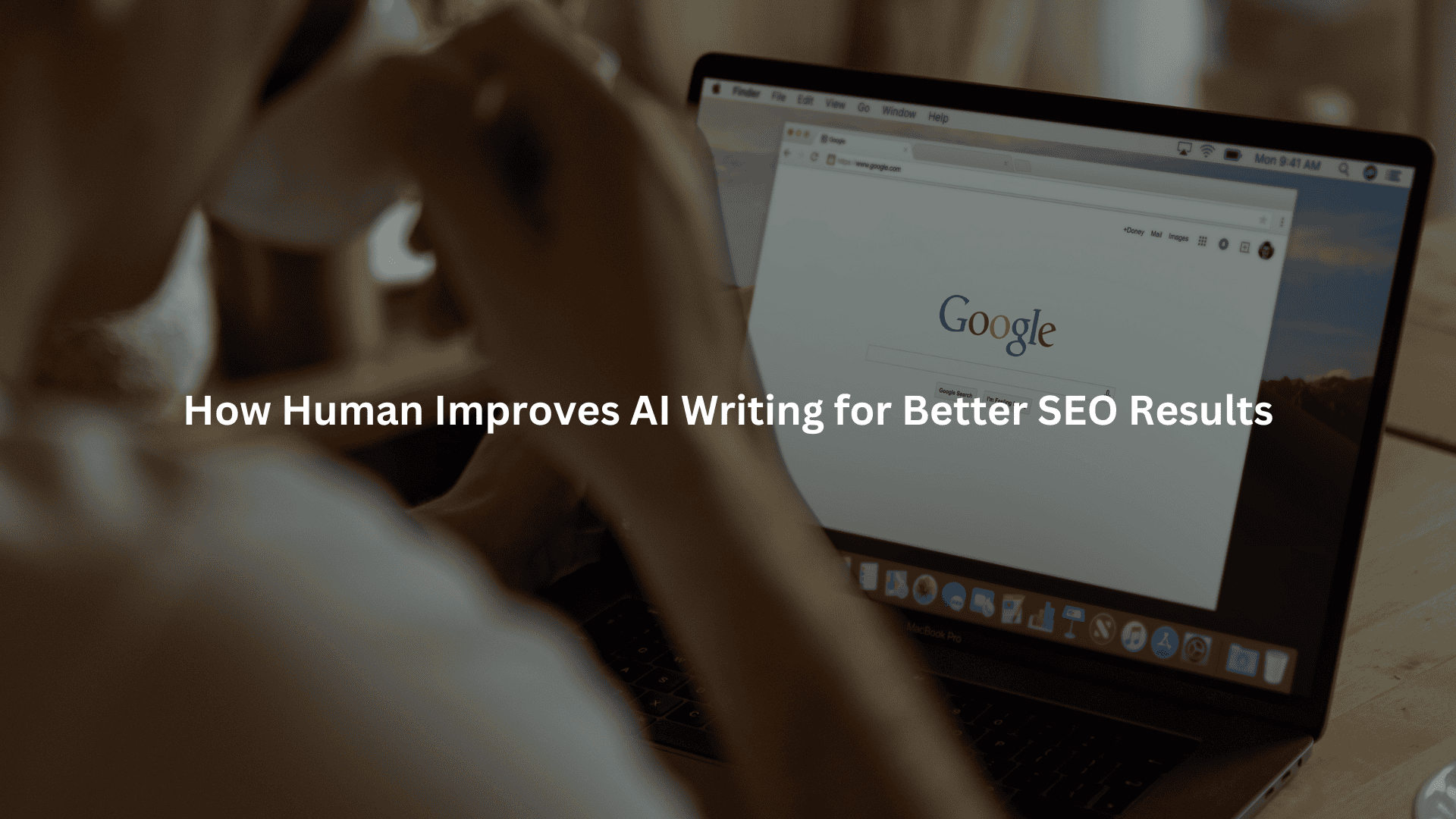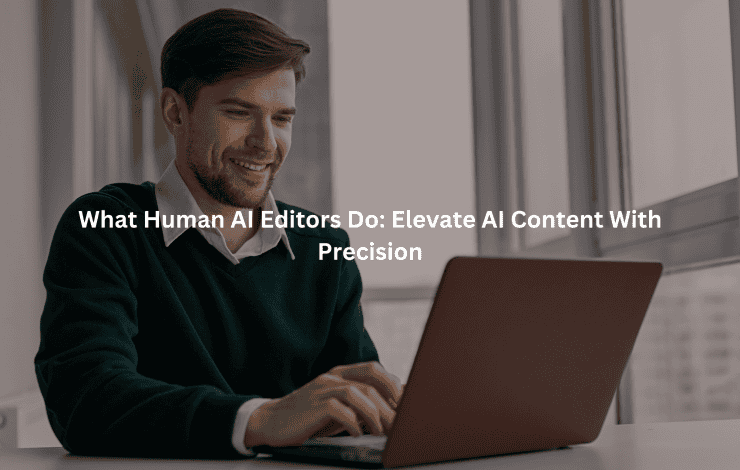You notice it right away, AI writing tools spit out content fast, but something’s missing. The words line up, sure, but they don’t always feel like they’re written for anyone in particular. There’s a gap, maybe in the way the sentences flow or how the ideas connect. Real people can spot it. That’s where human editors step in.
They shape rough drafts into something that actually speaks to readers, adding a bit of personality and fixing up the details that matter for SEO (think keywords, headings, and relevance). Without that human touch, most AI content just sits there, flat and forgettable.
Key Takeaway
- Human editors add clarity, feeling, and fact-checking, which makes AI-written content more believable and effective.
- When people handle SEO, they work in real meaning, connect topics, and keep the brand’s voice steady.
- Regular feedback and careful review help keep the writing fresh, interesting, and in step with changing search rules.
Human Editing and Feedback Integration
First thing that hits you with a new AI draft, something’s off. Not always obvious, but it’s there, a detail out of place or a fact that just doesn’t sit right. Editors don’t hunt for mistakes just to nitpick, it’s more about knowing machines can’t catch everything. Speed’s great, but it’s not enough. At Jet Digital Pro, they built their whole process around this, making sure every piece gets more than a quick once-over.
Factual Accuracy and Relevance
Correcting Information and Data
AI spits out words fast, but facts? Not so much. There was this technical blog about Google’s algorithm changes, and the AI pulled numbers from 2019, plus mentioned features that were long gone.
The team had to rip it apart, check every stat, and swap in current info. It’s not about being picky, it’s about trust. If a post says “42% jump in organic traffic,” it better be true. They always double-check sources, especially for YMYL topics (think finance or health), where getting it right isn’t optional.
Audience Alignment
Readers aren’t all the same. Once, they ran a series on keyword research tools for agencies, and the AI aimed it at newbies. But the real audience wanted advanced stuff. So the editors rewrote big chunks, shifting tone and examples to match.
For B2B, they cut the fluff and got technical. For ecommerce, it’s more straight talk and real cases. Context changes everything. They keep a doc of target personas for agency clients, so every edit lines up with what those readers actually want.
Iterative Refinement and Clarity
Structural Improvements
AI gets stuck in patterns, same length sentences, same structure, paragraph after paragraph. Editors break it up. Short lines, then a long, winding one. Lists when it fits. Sometimes a section starts with a stat, “Organic traffic up 30% with topic clusters”, then dives into the details. This mix keeps people reading, and it shows Google the content’s crafted, not just churned out.
Engagement Tactics
Stories stick. A dry article turns memorable with the right story, like fixing a broken keyword plan for a SaaS company, or rebuilding 40 posts after a Google update. Toss in a rhetorical question (“What if your content’s just like everyone else’s?”), maybe a little humor. It’s not just about ticking engagement boxes. The goal’s for someone to finish reading and feel like they learned from a real person, not just another bot.
Customization for SEO and Brand Voice

The thing about AI writing is that, left alone, it’s painfully generic. But with enough guidance, you can shape it into something that fits your brand and climbs search rankings. Jet Digital Pro made it a rule: every draft must sound like it belongs to the client who ordered it, not to the algorithm that built it.
Personalization and Style Training
Tone and Voice Adaptation
We always start with samples. If a client has a favorite post, we feed it to the AI and use it as a training guide. But it’s never as simple as copy-paste. We remember working with an agency that wanted a conversational, slightly irreverent tone.
The AI’s first drafts were too stiff. We had to rewrite, adding contractions, asides, and “you” statements until it sounded right. Explicit guidelines help: one client wanted every intro to include a question, every outro to suggest a next step. We built that into the prompt and editing checklist.
Consistency Across Content
Nothing tanks a brand faster than inconsistency. If the homepage says “clients,” but the blog says “customers,” readers notice. We keep terminology tight. We create word lists for every project. We’ve seen AI alternate between “search engine optimization” and “SEO” in the same paragraph, fixing that is non-negotiable.
We also keep messaging aligned. If a brand’s promise is “measurable growth,” we thread that phrase throughout the site, in titles, in meta descriptions, in CTAs. Brand voice isn’t just about sound, it’s about substance.
Advanced SEO Optimization
Keyword Research and Integration
Keyword research is the heart of content marketing. We use tools like SEMrush and Google Keyword Planner, but the real magic is in mapping those words to the content itself. AI can stuff a paragraph with keywords, but only we can weave them in naturally.
For a post on “organic traffic,” we’ll blend in “SEO optimization,” “content strategy,” “long-tail keywords,” and “semantic search.” We look for keyword variations, then map them to headings, subheadings, and body text. This makes the writing more discoverable without making it unreadable.
On-Page SEO and Topic Clustering
We always build clusters around main topics. For example, if the core keyword is “AI writing,” we’ll link to related posts on “semantic keywords,” “on-page SEO,” and “content engagement.” We use LSI (Latent Semantic Indexing) keyword generators to find related terms, then integrate them into the content map.
We’ve seen a 25% increase in search visibility for clients just by clustering articles around semantic themes. It’s not about gaming the algorithm. It’s about showing Google that your site is an authority on everything related to a core subject. [1]
Feedback Loops and Continuous Improvement
We believe in feedback. Not just from editors, but from readers and the data itself. Every piece of content is a draft, even after it’s published. We treat it like that at Jet Digital Pro, always open to tuning, never set in stone.
Interactive Feedback and User Insights
Content Review Cycles
Before any post goes live, it gets at least two rounds of edits. First, an editor checks for clarity, context, and SEO. Then, another reads it for flow and voice. We also ask agency clients to share feedback from their clients. If someone says, “This blog feels too generic,” we know we missed the mark. After publishing, we watch for comments and bounce rates. If a post loses readers halfway through, we dig in and rewrite.
Data-Driven Adjustments
Numbers don’t lie. We track rankings, traffic, time on page, and engagement for every article. If a keyword drops out of the top ten, we look for gaps, maybe the intent changed, maybe there’s a new competitor.
Sometimes, a post will shoot up in rankings just from adding a new section or fixing a headline. We’ve seen bounce rates drop by 14% after breaking up a 1,500-word block into shorter sections with clear H2s and bulleted lists. Data guides every adjustment, but we always bring a human perspective to what the numbers mean.
Ethical Standards and Content Authenticity
Transparency and Originality
We’ve made it a policy to be upfront about AI use. If a client wants, we add a note at the end: “This article was created with the assistance of AI and reviewed by our editorial team.” There’s no shame in using tools, but there’s pride in refining the work until it’s original. Plagiarism checks are standard. Every draft runs through Copyscape or Grammarly. We once caught an AI trying to sneak in a Wikipedia paragraph, didn’t make the cut.
Avoiding Over-Optimization
Keyword stuffing is easy to spot. It reads like a bad script. Instead, we focus on natural phrasing. A good rule: if you say the same keyword more than twice in a paragraph, you’re overdoing it. We use keyword density tools, but we also rely on gut checks, if it sounds weird, it is weird. The best SEO content reads like a conversation, not a checklist.
Human-AI Collaboration: Efficiency and Strategy

There are things AI does better than us. There are things we do better than AI. The trick is knowing who should do what. At Jet Digital Pro, we’ve built our workflow around this balance, and it saves us hours every week. [2]
Division of Tasks for Productivity
Repetitive vs. Creative Work
We let AI handle grammar checks, spelling, even first-pass keyword integration. It’s fast, and it gets us to a workable draft in minutes instead of hours. But when it comes to storytelling or strategic planning, that’s us.
We’ll give an example. We used AI to outline a series of articles on “content engagement.” The AI came up with a basic structure, then we filled in the gaps with stories about client wins, case studies, and personal failures. The result? Content that’s both efficient and engaging.
Workflow Framework
Are You a Digital Agency?
White Label SEO Content Services for Agencies
Scalable, customizable, and results-driven content solutions for your clients.
Templates are our best friend. Every new article starts with a step-by-step checklist: outline, draft, edit, optimize, review. We use Google Docs and project management tools like Asana to keep everyone on track.
For agencies, we offer white-label templates so they can plug our process into their own workflows. Communication is constant. If someone has a question about a keyword, they tag the team. If a post needs a rewrite, it goes back to draft, no questions asked.
Measuring and Enhancing Performance
SEO Tools and Analytics
We use every tool we can get. Google Analytics, SEMrush, Ahrefs, Moz. Each one gives us a different view of keyword rankings, search visibility, and content performance. Every month, we pull data and look for trends.
If “semantic relevance” is climbing in search queries, we build more content around it. If a page drops in ranking, we look at what changed, did Google update its algorithm, did a competitor publish something new? Our process is fluid, always adjusting to what the numbers tell us.
Adapting to Search Algorithms
Search algorithms don’t stand still. What worked last year might not work tomorrow. We stay ahead by reading updates, running tests, and talking to other editors. If Google starts favoring longer content, we expand key articles. If video snippets start topping the SERPs, we add embedded clips and transcripts.
Future-proofing isn’t about guessing. It’s about listening, watching, and responding. We don’t chase every trend, but we do pay attention. One shift in search intent can mean hundreds of lost or gained visitors a week. We adjust, retest, and keep going.
FAQ
How does human editing improve AI writing for better SEO optimization?
When humans review AI writing, they often catch where keyword integration feels forced or robotic. This helps adjust keyword density and makes the writing match user intent. Editors also reshape content for natural language processing, making it easier for search algorithms to understand. Good editing supports on-page SEO, improves search engine ranking, and boosts content quality across topic clustering strategies.
Why is human input necessary to align AI writing with real user intent?
AI writing tools may generate high volumes of content, but humans help shape it around actual search intent. Without human edits, AI might ignore subtle cues in search trends or misuse keyword suggestions. Editors improve contextual relevance and ensure keyword mapping matches what users are truly asking. This results in higher search visibility and better content engagement over time.
How do humans help AI avoid keyword stuffing while keeping keyword optimization strong?
Need a Strategic SEO Content Partner?
Let’s craft SEO content that ranks, converts, and grows your brand.
Talk to UsHumans spot overuse of target phrases that AI might repeat, keyword stuffing hurts SEO ranking factors. Human input helps balance keyword variations with content depth. Editors refine long-tail keywords, ensure semantic keywords are included naturally, and use keyword analysis to fine-tune placement. This way, content creation stays organic while maximizing SEO content writing and avoiding penalties in search algorithms.
In what ways do humans shape AI writing into a real content marketing asset?
AI may generate drafts, but only humans can shape those into useful content marketing tools. Writers organize ideas into keyword clusters, apply keyword planner insights, and format the structure around content strategy. Human guidance connects topic clustering to audience targeting, building content relevance that drives website traffic. It also improves digital marketing by aligning with evolving SEO best practices.
How does human involvement improve the semantic relevance of AI-generated writing?
AI often misjudges semantic search needs without human help. Editors step in to connect semantic keywords with surrounding context, building stronger semantic relevance. They restructure content to support keyword intent and improve keyword targeting. This strengthens keyword integration and makes SEO tools more effective. Human tuning also improves SEO performance by matching content to both user queries and search engine logic.
Conclusion
If you’re using AI for content, don’t hand over the keys and walk away. Ask the hard questions: does this help real people? Does it match your brand’s tone?
At Jet Digital Pro, we mix AI speed with real human editing, 11 steps deep. That’s how we keep content sharp, honest, and SEO-ready. The difference isn’t just tech. It’s who cares enough to get it right.
Let’s talk about scaling your content the right way.
References
- https://www.semrush.com/blog/topic-clusters/
- https://www.researchgate.net/publication/386225744_Human-AI_Collaboration_Enhancing_Productivity_and_Decision-Making
Related Articles
- https://jetdigitalpro.com/benefits-of-human-editing-ai-content/
- https://jetdigitalpro.com/role-and-value-of-human-ai-content-editors/
- https://jetdigitalpro.com/ai-content-editor/
P.S – Whenever you’re ready,
we’re here to help elevate your SEO content.
Partner with us for strategic, scalable content that drives real organic growth.
Contact Us Now




